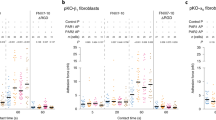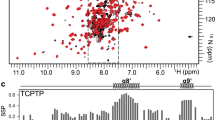Abstract
Synthetic peptides containing the arginine–glycine–aspartate (RGD) motif have been used extensively as inhibitors of integrin–ligand interactions in studies of cell adhesion, migration, growth and differentiation1,2,3, because the RGD motif is an integrin-recognition motif found in many ligands. Here we report that RGD-containing peptides are able to directly induce apoptosis without any requirement for integrin-mediated cell clustering or signals. We show that RGD-containing peptides enter cells and directly induce autoprocessing and enzymatic activity of pro-caspase-3, a pro-apoptotic protein. Using the breast carcinoma cell line MCF-7, which has a functional deletion of the caspase-3 gene, we confirm that caspase-3 is required for RGD-mediated cell death. In addition to an RGD motif, pro-caspase-3 also contains a potential RGD-binding motif, aspartate–aspartate–methionine (DDM)4, near the site of processing to produce the p12 and p17 subunits5. On the basis of the ability of RGD–DDX interactions to trigger integrin activation6, we suggest that RGD peptides induce apoptosis by triggering conformational changes that promote pro-caspase-3 autoprocessing and activation. These findings provide an alternative molecular explanation for the potent pro-apoptotic properties of RGD peptides in models of angiogenesis, inflammation and cancer metastasis7,8,9.
This is a preview of subscription content, access via your institution
Access options
Subscribe to this journal
Receive 51 print issues and online access
$199.00 per year
only $3.90 per issue
Buy this article
- Purchase on Springer Link
- Instant access to full article PDF
Prices may be subject to local taxes which are calculated during checkout





Similar content being viewed by others
References
Ruoslahti, E. RGD and other recognition sequences for integrins. Annu. Rev. Cell Dev. Biol. 12, 697–715 (1996).
Meredith, J. E. & Schwartz, M. A. Integrins, adhesion and apoptosis. Trends Cell Biol. 7, 146–150 (1997).
Werb, Z. ECM and cell surface proteolysis: regulating cellular ecology. Cell 91, 439–442 (1997).
Pasqualini, R., Koivunen, E. & Ruoslahti, E. Apeptide isolated from phage display libraries is a structural and functional mimic of an RGD-binding site on integrins. J. Cell Biol. 130, 1189–1196 (1995).
Nicholson, D. W. et al. Identification and inhibition of the ICE/ced-3 protease necessary for mammalian apoptosis. Nature 376, 37–43 (1995).
Du, X. P. et al. Ligands activate integrin αIIbβ3 (platelet gpIIb-IIIa). Cell 65, 409–416 (1991).
Humphries, M. J., Olden, K. & Yamada, K. M. Asynthetic peptide from fibronectin inhibits experimental metastasis of murine melanoma-cells. Science 233, 467–470 (1986).
Ferguson, T. A., Mizutani, H. & Kupper, T. S. Two integrin-binding peptides abrogate T cell-mediated immune-responses in vivo. Proc. Natl Acad. Sci. USA 88, 8072–8076 (1991).
Brooks, P. C. et al. Integrin αvβ3 antagonists promote tumor-regression by inducing apoptosis of angiogenic blood-vessels. Cell 79, 1157–1164 (1994).
Salmon, M. et al. Inhibition of T cell apoptosis in the rheumatoid synovium. J. Clin. Invest. 99, 439–446 (1997).
Lwebuga-Mukasa, J. S. AMn2+-enhanced, RGD-dependent adhesion technique for isolation of adult rat type II alveolar epithelial cells for immediate functional studies. Am. J. Resp. Cell Mol. Biol. 10, 347–354 (1994).
Yamada, K. M. & Miyamoto, S. Integrin transmembrane signaling and cytoskeletal control. Curr. Opin. Cell Biol. 7, 681–689 (1995).
Jacobson, M. D. Programmed cell death: a missing link is found. Trends Cell Biol. 7, 467–469 (1997).
Salvesen, G. S. & Dixit, V. M. Caspases: intracellular signaling by proteolysis. Cell 91, 443–446 (1997).
Thornberry, N. A. & Lazebnik, Y. Caspases: enemies within. Science 281, 1312–1316 (1998).
Henkart, P. A. ICE family proteases—mediators of all apoptotic cell death? Immunity 4, 195–201 (1996).
Martin, D. A., Siegel, R. M., Zheng, L. X. & Lenardo, M. J. Membrane oligomerization and cleavage activates the caspase-8 (FLICE/mach α1) death signal. J. Biol. Chem. 273, 4345–4349 (1998).
MacCorkle, R. A., Freeman, K. W. & Spencer, D. M. Synthetic activation of caspases: artificial death switches. Proc. Natl Acad. Sci. USA 95, 3655–3660 (1998).
Yang, X. L., Chang, H. Y. & Baltimore, D. Essential role of ced-4 oligomerization in ced-3 activation and apoptosis. Science 281, 1355–1357 (1998).
Pan, G. H., O'Rourke, K. & Dixit, V. M. Caspase-9, Bcl-xL, and APAF-1 form a ternary complex. J. Biol. Chem. 273, 5841–5845 (1998).
Janicke, R. U., Sprengart, M. L., Wati, M. R. & Porter, A. G. Caspase-3 is required for DNA fragmentation and morphological changes associated with apoptosis. J. Biol. Chem. 273, 9357–9360 (1998).
Frisch, S. M. & Francis, H. Disruption of epithelial cell-matrix interactions induces apoptosis. J. Cell Biol. 124, 619–626 (1994).
McGill, G., Shimamura, A., Bates, R. C., Savage, R. E. & Fisher, D. E. Loss of matrix adhesion triggers rapid transformation-selective apoptosis in fibroblasts. J. Cell Biol. 138, 901–911 (1997).
Hayman, E. G., Pierschbacher, M. D. & Ruoslahti, E. Detachment of cells from culture substrate by soluble fibronectin peptides. J. Cell Biol. 100, 1948–1954 (1985).
Boucaut, J. C. et al. Biologically-active synthetic peptides as probes of embryonic-development—a competitive peptide inhibitor of fibronectin function inhibits gastrulation in amphibian embryos and neural crest cell-migration in avian embryos. J. Cell Biol. 99, 1822–1830 (1984).
Dsouza, S. E., Ginsberg, M. H. & Plow, E. F. Arginyl-glycyl-aspartic acid (RGD)—a cell-adhesion motif. Trends Biochem. Sci. 16, 246–250 (1991).
Zou, H., Henzel, W. J., Liu, X. S., Lutschg, A. & Wang, X. D. APAF-1, a human protein homologous to C-elegans ced-4, participates in cytochrome c-dependent activation of caspase-3. Cell 90, 405–413 (1997).
Chinnaiyan, A. M., O'Rourke, K., Lane, B. R. & Dixit, V. M. Interaction of ced-4 with ced-3 and ced-9: a molecular framework for cell death. Science 275, 1122–1126 (1997).
Li, C. J., Friedman, D. J., Wang, C. L., Metelev, V. & Pardee, A. B. Induction of apoptosis in uninfected lymphocytes by HIV-1 Tat protein. Science 268, 429–431 (1995).
Hu, Y. M., Benedict, M. A., Wu, D. Y., Inohara, N. & Nunez, G. Bcl-xL interacts with APAF-1 and inhibits APAF-1-dependent caspase-9 activation. Proc. Natl Acad. Sci. USA 95, 4386–4391 (1998).
Acknowledgements
We thank N. Shamsadeen, M. Zwede and D. Hardie for technical assistance. This work was funded by grants from the Arthritis Research Campaign (to D.P., D.S.-T., M.S.), The Royal Society (to J.M.L.), Cancer Research Campaign (to N.V.H.), Medical Research Council (to G.P., K.T., A.N.A.) and Wellcome Trust (C.D.B., D.L.S.).
Author information
Authors and Affiliations
Corresponding author
Rights and permissions
About this article
Cite this article
Buckley, C., Pilling, D., Henriquez, N. et al. RGD peptides induce apoptosis by direct caspase-3 activation. Nature 397, 534–539 (1999). https://doi.org/10.1038/17409
Received:
Accepted:
Issue Date:
DOI: https://doi.org/10.1038/17409
This article is cited by
-
Carfilzomib relieves pancreatitis-initiated pancreatic ductal adenocarcinoma by inhibiting high-temperature requirement protein A1
Cell Death Discovery (2024)
-
Strategic Approaches to Improvise Peptide Drugs as Next Generation Therapeutics
International Journal of Peptide Research and Therapeutics (2023)
-
Evaluation of anticancer activity in vitro of a stable copper(I) complex with phosphine-peptide conjugate
Scientific Reports (2021)
-
Comparison of MS2, synchronous precursor selection MS3, and real-time search MS3 methodologies for lung proteomes of hydrogen sulfide treated swine
Analytical and Bioanalytical Chemistry (2021)
-
Antibacterial Activity of Cysteine-Derived Cationic Dipeptides
International Journal of Peptide Research and Therapeutics (2020)
Comments
By submitting a comment you agree to abide by our Terms and Community Guidelines. If you find something abusive or that does not comply with our terms or guidelines please flag it as inappropriate.



